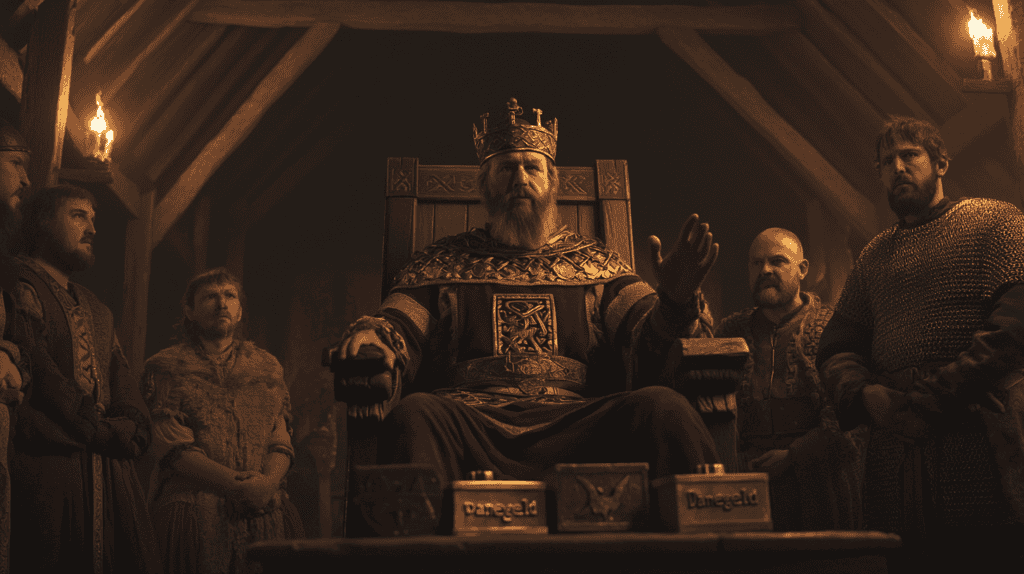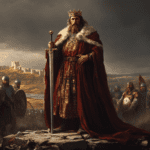
The battle took place in August 991 AD near Maldon beside the River Blackwater in Essex, England, during the reign of Æthelred the Unready. Earl Byrhtnoth and his thegns led an English militia against a Viking invasion. The battle ended in an Anglo-Saxon defeat. After the battle Archbishop Sigeric of Canterbury and the aldermen of the south-western provinces advised King Æthelred to buy off the Vikings rather than continue the armed struggle. The result was a payment of Danegeld of 10,000 Roman pounds (3,300 kg) of silver (approx £1.8M at 2022 prices).

One manuscript of the Anglo-Saxon Chronicle states that a certain Olaf, possibly the Norwegian Olaf Tryggvason, led the Viking forces, these estimated to have been around 3,000 warriors. The forces engaged by the Anglo-Saxon were raiding, or (in Old Norse) “í víking”, to gather loot, rather than to occupy land for settlement. Therefore, if Byrhtnoth’s forces had kept the Vikings off the mainland by guarding the causeway or by paying them off, Olaf would likely have sailed farther up the river or along the coast, and raided elsewhere.
As a man with troops and weapons, it might be that Byrhtnoth had to allow the Vikings ashore to engage his force in order to protect other communities along the coast. A source from the 12th-century Liber Eliensis, written by the monks at Ely, suggests that Byrhtnoth had much fewer men to command: “he was neither shaken by the small number of his men, nor fearful of the multitude of the enemy”. Not all sources indicate such a disparity in numbers.
At the time of battle, English royal policy of responding to Viking incursions was split. Some favoured paying off the Viking invaders with land and wealth, while others favoured fighting to the last man. Evidence suggests that Byrhtnoth held this latter attitude, hence his moving speeches of patriotism.

The battle
The Vikings sailed up the Blackwater (then called the Panta), and Earl Byrhtnoth called out his levy, the fyrd. The poem begins with him ordering his men to stand and to hold weapons. His troops, except for personal household guards, were local farmers and villagers of the Essex Fyrd militia. He ordered them to “send steed away and stride forwards”: they arrived on horses but fought on foot.
The Vikings sailed up to a small island in the river and disembarked ready to fight. At low tide, the river leaves a land bridge from this island to the shore; the description seems to have matched the Northey Island causeway at that time. This would place the site of the battle about two miles southeast of Maldon.
The Viking leader Olaf addressed the Saxons on the shore from the small island just offshore, promising to sail away if he was paid with gold and armour from the lord. Byrhtnoth shouted a reply, “We will pay you with spear tips and sword blades.”

As the tide fell, revealing the causeway to the island, Olaf’s forces began an assault across the small land bridge. Three Anglo-Saxon warriors, Wulfstan, Ælfhere and Maccus blocked the bridge, successfully engaging any Vikings who pressed forward. Deadlocked, the Viking commander requested that Byrhtnoth allow his troops onto the shore for a battle so that matters could be settled. Byrhtnoth, maybe out of duty or eagerness for battle, let the enemy force cross to the mainland and battle was joined.
The causeway the Vikings had to cross from Northsey Island to fight the Saxons on the mainland
Backing away from the causeway to the island, the Saxon army formed for battle and deployed behind a shield wall. As the Vikings advanced behind their own shield wall, the two sides exchanged arrows and spears. Coming into contact, the battle became hand-to-hand as the Vikings and Saxons attacked each other with swords and spears.
Unfortunately, a Saxon called Godrīc fled riding Byrhtnoth’s horse. Godrīc’s brothers Godwine and Godwīg followed him. Then recognizing the horse and thinking that its rider was Byrhtnoth fleeing, many Saxon fighters also fled. To add insult to injury, it is stated that Godric had often been given horses by Byrhtnoth, a detail that, especially during the time period, would have had Godric marked as a coward and a traitor, something that could have easily been described as worse than death.
The remaining Saxons fought on. After a protracted period of fighting, the Vikings began to focus their assault on Byrhtnoth. This attack proved successful and the Saxon leader was struck down. With his death, the Saxon resolve began to waver and much of the fyrd began to flee into the nearby woods.
Though the bulk of the army had melted away, Brihtnoth’s retainers continued the fight. Standing fast, they were slowly overwhelmed by the superior Viking numbers. They were eventually defeated, but not before they succeeded in inflicting heavy losses on the enemy.

Aftermath
After the battle Byrhtnoth’s body was found with its head missing, but his gold-hilted sword was still with his body. Both sides took substantial losses and the Vikings found it difficult to man their ships after the battle and were forced to sail away rather than attack and pillage the nearby town of Maldon. With England’s defenses weak, King Aethelred was advised by Archbishop Sigeric of Canterbury pay tribute the Vikings rather than continue an armed struggle. Agreeing, he made an offering of 10,000 pounds of silver which became the first in a series of Danegeld payments.Though having won a victory, Viking losses were such that they returned to their ships rather than press their advantage with an assault on Maldon.





